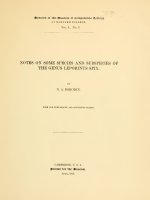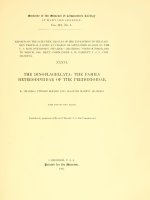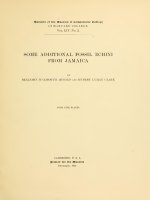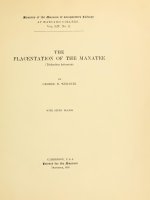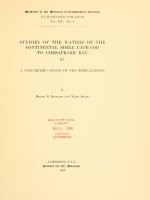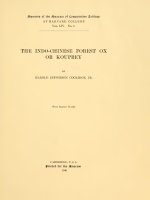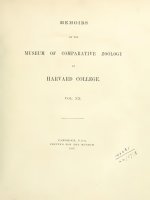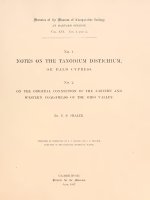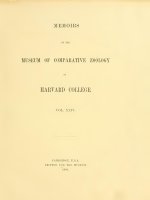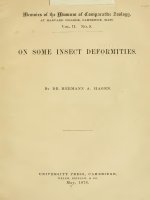Memoirs MCZ 2503
Bạn đang xem bản rút gọn của tài liệu. Xem và tải ngay bản đầy đủ của tài liệu tại đây (4.17 MB, 71 trang )
—
/Demolrs ot tbe /IDuseum of Comparative Zoology
AT HARVARD COLLEGE.
Vol.
XXV.
No.
3.
SOME NEW AMERICAN FOSSIL
CRINOIDS.
BY
FRANK SPRINGER.
WITH
SIX PLATES.
CAMBRIDGE,
IPrtnte5
for
U.
S. A.:
tbe nDuseum.
July, 1911.
'
-i)
SOME NEW AMERICAN FOSSIL CRINOIDS.
During somewhat
have come into
my
to species hitherto
protracted researches upon the
possession a considerable
un described, and
of species imperfectly
much
also
in
some specimens
purpose, already too long delayed, tempts
new
me
there
of specimens belonging
figures.
due course of systematic work.
of a remarkable
Crinoids,
excellent material illustrative
known, or described without
remain to be dealt with
describing
number
fossil
Most
The
obligation of
species entrusted to
to publish along with
of these
it
me
for that
some others
which are specially notable, either by way of extending the stratigraphic or
geographic range of certain groups, illustrating species hitherto unfigured, or
throwing
appeal to
which
I
upon unsettled questions of classification. These objects, which
me with more interest than the mere description of new species, and
light
am
sure are of greater service to science, have induced the present
contribution.
CAMERATA.
DIMEROCRINIDAE.
DiMEROCRiNUS
apud Miu-chison.
Phillips
1881.
Silurian System, p. 674, PI. XVII, figs. 4, 5.
Dimerocrinus Wachsmuth and Springer, Revision of the Palaeocrinoidea,
1897.
Thysanocrinus Id. N. Amer. Crin. Cam., 190.
1836.
II,
197;
III, 101.
This hitherto exclusively Silurian genus was proposed by PhiHips without
definition,
but upon two species, D. decadactylus and D.
he gave a brief description and figures
bj'
as familiar forms at Dudley, England;
principal
museums, under
Phillips's
icosidactylus, of
which they can be
which
easily recognized'
specimens of them are found in the
names.
From
these species the generic
characters are readily determinable, but were not correctly understood until
FOSSIL CRINOIDS.
118
Wachsmuth and
pointed out by
basals, not observed
by PhiUips or other authors
Phillips's
genus (Rev.
Pal., II, 198);
discovered the infra-
made them
This
before.
we then ranked
congeneric with Hall's later Thysanocrinus, which
under
who
Springer in 1881,
as a
synonym
an arrangement which we afterwards,
without good reason, reversed (N. A. Crin. Cam., 190), taking Hall's name,
Thysanocrinus, for the genus and family.
cised,
and must be abandoned.
This procedure has been justly
Therefore
I
use the
names
head
at the
criti-
of this
and Thysanocrinus, as adopted in the North
American Crinoidea Camerata, and for the same generic type, viz a Camerate,
section instead of Thysanocrinidae
:
dicyclic Crinoid, with radials in contact except at the anal side;
of interbrachial plates;
crinus
and Glyptaster
biserial
clearly
and anus without a tube.
arms;
go
as
several ranges
synonyms.
Angelin's Eucrinus, which
included several species substantially like D. decadaciylus, was at
to be upheld
by
Thysano-
first
sought
restricting Dimerocrinus to species with only ten simple arms;
but the addition of another order of brachials, giving twenty arms simple
like
the others, seemed such a very slight modification of the same plan of structure,
that this distinction was afterwards abandoned, and
all
the species thrown
together under Dimerocrinus except the two figured by Angelin as E. venustus
and E. minor
(Icon. Crin.
PI.
Suec,
XV,
5,
figs.
7,
16).
In these there
is
a
wholly different arm structure, with frequent branching at long intervals, and
the arms from the IIBr up, below the axillaries as well as above, biserial, as in
These, however, appeared from the figures
Megistocrinus, Abacocrinus, etc.
to
have the radials separated
we proposed
What
is
all
around as
them
in the Rhodocrinidae,
and
for
we have the
first
evidence
the genus Anthemocrinus.
of especial interest
now, however,
of persistence of this family type into the
is
that
Middle Devonian.
But
for the
non-
and somewhat obscure Lower Devonian form described by Jaekel
as Orthocrinus, the known species of this family have been restricted to the
characteristic
Silurian
and
earlier.
Schultze's
"
Rhodocrinus" quinquelobus, which he classed
with Thysanocrinus, and which we placed under Eucrinus (Rev.
is
— a Batocrinoid, as
monocyclic
from the Hamilton beds near
will
be shown
Louisville,
later.
A
Pal., II, 197),
very distinct specimen
with a calyx which cannot be excluded
from the family diagnosis, compels us to extend
its
range accordingly.
FOSSIL CRINOIDS.
DiMEROCRINUS SPINIFERUS,
Plate III,
Calyx elongate with straight
trum
figis.
sides,
119
sp. IIOV.
lla-d.
truncate above and below like the frus-
an inverted pyramid; rather wider than high, widest just above the
arm bases, enlarging from base to arm facets as 1 to 1.8; IBB and lower part of
BB
of
included in lower plane.
mm.; width
IBB
of
at base, 10
good
Dimensions
arm
at
mm.,
of the only specimen:
horizontal, projecting well
size,
mm.
bases, 18.5
height 17.5
Base broad and
flat;
beyond the column, with tips
IBB — the largest
—
the lower central part produced into spiny nodes, about
plates in the calyx
bending up;
on a
level
BB
three times as wide and twice as high as
with the infrabasals; smaller spines form a low ridge leading from
RR
these to the middle of the radials.
a
little
thirds as high,
surmounted by a small spine
normally three
in
one ray) one fourth the
;
wider than BB, but only two
followed by two narrow IBr (ab-
size of the radials, also spiniferous;
and these by one very large, overhanging, spiniferous IIBr at each side, bearing
the arm facets; between these a large, wedge-shaped, tumid plate, and above
this a pair of further projecting spinous plates
the widest part of the calyx.
overhang the arm facets and mark
First iBr large, followed
by two
plates,
and then
two ranges more connecting with others in the tegmen, each bearing a
central spine;
leading to a subcentral opening in the tegmen.
arms unknown.
facets very small;
all
plates bear one or
and the tegmenal
and well defined.
Type.
short,
anal area similar, with three plates in the second range,
more small
Arm
and
openings two to the ray;
Tegmen moderately
lobed, perfectly flat;
spines, the largest being
on the posterior
oral
margin above the arm bases; oral plates large
Column facet large and round.
axillaries at the
In the author's collection.
Horizon and Locality.
Hamilton Group
of the
Middle Devonian.
Charles-
ton, Clark county, Indiana.
The
description
but the unique type
much
is
is
rather
more
series give to the calyx a strikingly angular
appearance, unlike that of any other of the genus.
may
desirable,
distinct,
rows passing from basals up the radial
size of the facets I suspect there
is
and others would probably not show
the characters stated.
The spiny ridges and
remarkably
substantial variation in
of the individual specimen than
From
the extremely small
was something peculiar about the arms; but we
not expect to see them, as they are almost never found preserved in the
FOSSIL CRINOIDS.
120
they come out from under the overhanging
Crinoids of that prolific locality;
tegmen plates much
and were no doubt as
like those of Gilbertsocrinus,
small,
and not improbably pendent.
BATOCRINIDAE.
DoRYCRiNUS Roemer.
This case
is
the reverse of the
Instead of bringing a Silurian genus
last.
forward to the Devonian, we have a species which carries a Carboniferous genus
back
in
The Batocrinidae
to that age.
{sensu
but Dorycrinus and
the Ordovician;
its
Wachsniuth and Springer) began
immediate congeners have been
"
Lower Carboniferous, except for Actinocrinus " cassedayi Lyon, and some unfigu red species by Hall from the New York Hamilton,
and the small "Actinocrinus" prumiensis of Miiller, to which must be added for
hitherto restricted to the
i-easons already stated, the
"
spiniferous Dorycrinus, until now, has been supposed
Burlington Limestone; but here
locality as the last:
The
Rhodocrinus" quinquelobus of Schultze.
—
is
to begin in the
Lower
a good one from the Hamilton, at the same
Dorycrinus devonicus,
Plate III,
figs.
sp.
12o-d,
nov.
13.
Caljrx elongate, narrowly turbinate to the first axillary, greatly enlarged
deeply lobed above;
spreading as from
sides to 3 at the axillary IBr,
real
1
and
at the base gradually with straight
and then suddenly
to 5 at the
arm
bases
;
narrowly
truncate below, and highly arched in the tegmen with deep interbrachial con-
tegmen much larger than dorsal cup, and bearing large projecting
Dimensions of medium sized specispines on the interambulacral axillaries.
men: height to bottom of arm bases, 12 mm.; total height, 23 mm.; width at
strictions;
base, 4
mm.;
at axillary IBr, 12;
Basals forming an erect cup.
and
at
arm bases
— the widest part — 21 mm.
Radial series elongate, with low median ridge,
diminishing in width and branching twice in the calyx, giving 4
to the ray, facing
elongate;
outward
arm openings
arm openings
lower edge of arm
in large projecting lobes;
radial lobes very large, being,
from the
nearly as high as the whole of the dorsal cup below them;
tuberance stands above each pair of
arm
bases,
large
and
facets up,
a large hollow pro-
and another
still
larger one
FOSSIL CRINOIDS.
above and between them
in the
tegmenal
121
Arms unknown.
axil.
spaces wide, occupied by about 5 ranges of plates, in order
dorsal cup,
and several more above the
level of
Anal area
to a connection with the orals.
arm
bases,
Interbrachial
between the lobes
similar, with 3 plates in the
range, leading to a subcentral opening in the tegmen, directed up.
high, low convex on top, broadly curving
down
interradially
in the
1, 2, 3, etc.,
second
Tegmen
between the
lobes,
which are very high, surmounted by the protuberances already mentioned;
•these are hollow, composed of small plates, and formed the sockets for large
spines,
none of which are preserved; tegmen plates very small and numerous;
Column
orals not differentiated.
Types.
in
Figs. V2a-d are in
facet round, filling entire width of base.
Walker Museum, University
of Chicago.
Fig. 13,
author's collection.
Hamilton Group, Middle Devonian.
Horizon and Locality.
Charleston,
Clark county, Indiana.
Besides the two very good specimens figured,
I
have three others not so
complete, but showing the characters of the species with remarkable constancy;
the low radial ridge
that
I
know
is
equally distinct in
The
all.
nearest related form to this
the species from an about e([uivalent horizon in the Eifel, de-
is
scribed
as Rhodocrinus quinquelobus
PI.
similar narrow, turbinate, elongate calyx, with prominent
by Schultze
VH), which has a
lobes in the radial regions;
but no spines.
he with
it
from that group, considering
is
(loc. cit., 57, text-fig. 10),
The
difficulty
more than
I
wholly incorrect and misleading;
can understand.
with radials separated
a single "ziemlich
all
(loc. cit., PI. VII, 6).
The diagram
it
20 arms.
we withdrew
"
how
from
it
was based upon
and "verdriickte" specimen,
exposed, and of which only that view
unvollstandigen
Schultze,
his specimen,
represents a dicyclic Crinoid
around by a large interradial plate;
the posterior side was chiefly
its
grows out of the above
careful observer as he usually was, could have constructed
is
its affinities
a Rhodocrinoid (N. A. Crin. Cam., 192);
it
neither of these assignments can stand.
mentioned diagram, which
57,
Wachsmuth
under Eucrinus on account of
Afterwards, following Schultze's diagram
it
Schultze declared
Thysanocrinus, as a subgroup within Rhodocrinus.
and Springer accordingly placed
Eifelk.,
This species has been the subject
of uncertain treatment in systematic literature.
to
(Mon. Echin.
in
is
which
figured
This figure shows three large basal plates, each followed
somewhat nodose, radials, and these in succession by two
primibrachs, the second one axillary and leading to two arm openings; that is,
four ranges of plates up to and including the axillary brachials (radials of third
alternately
by
large,
FOSSIL CRINOIDS.
122
order as then called)
like that there is
;
there
is
no sign of infrabasals, and in a slender dorsal cup
no possible room for interradials between the
Yet
radials.
in
the diagram there are five infrabasals, large basals, and three orders of radials
including the axillary.
description combines the facts of the figure with
The
the errors of the diagram in a singular way, indicating a strange confusion of
ideas.
Slightly condensed
it
reads as follows:
The "Basaha" (number not
form a low funnel, to which circumstance the calyx owes its elongate
form (showing that he means the first row of erect plates seen in the figure,
stated)
and not any
invisible plates below, or above,
them)
;
the lower part of the six-
sided "Parabasalia" project "knopformig" (answering precisely the description
of the (first) radials in the figure)
;
upon
these,
which consists
angles, follow five rays, each of
is
of "drei Radialia," the
upper of
beyond a doubt that the lowest
these axillary (whereas the figure shows
three radials whose upper plate
into their reentering
wedged
the axillary,
is
the
"
of the
"
knopfformig
plate,
resting upon the reentering angles of the "Basalia" which form the "Trichter,"
and that there
rest
is
no room
for
any "Parabasalia" at
upon the horizontally truncate edge
Interradial of the
in the second
first
all)
;
the Interradials, which
of the "Parabasalia," shov.^ a larger
order, etc. (the only possible horizontally truncate plates
range are the radials and the anal plate, which the author must
have been thinking of when he wrote this).
I have good specimens of an undescribed elongate form substantially the same
as Schultze's species, from the
Devonian
of Colle, Spain,
— a perfectly
plain
Batocrinoid.
INADUNATA.
GASTEROCOMIDAE.
Hitherto no representative of the assemblage of peculiar dicyclic Eifelian
the
genera grouped under this family has been reported in this country, except
It is now known,
species described by Hall under Myrtillocrinus americanus.
however, that there are at least two other genera in our approximately equivalent
Middle Devonian that must be referred
to
it.
The genus Arachnocrinus was founded by Meek and Worthen (Geol. Surv.
Hall as Cyathocrinus
Illinois, II, 177) upon a species which had been described by
bulbosus (15th Rept. N. Y. St. Cab., 1860, 123) from the
Helderberg =
Corniferous) of western
New
York;
this
Onondaga (= Upper
was done chiefly upon
FOSSIL CRINOIDS.
the character of
its
the structure of
its
ponderous arms, and without any accurate knowledge of
It was said to have small infrabasals (afterwards
calyx.
by Wachsmuth and Springer, Rev.
stated
plate resting
123
Pal., I, 94, as five),
upon the truncated posterior basal; and
I,
single anal
for these reasons
Wachsmuth and
always been ranked among the Cyathocrinidae.
(Rev. Pal.,
and a
has
it
Springer
two additional species from the equivalent rocks
Kentucky, in one of which they observed a lateral opening
94) described
near Louisville,
above the posterior basal, and between two adjoining radials; but this
attracted no special attention.
Nothing was then known of any unusual
directly
fact
features of the
column or
axial opening.
Investigation of the original specimens upon which these several species were
described, and of a considerable quantity of additional material since obtained
from the typical
New York and
localities in
near Louisville, has disclosed with
perfect clearness the characters of the calyx;
leading to the interesting result
that the remarkable arms of the American species belong to a calyx in no
distinguishable from certain Eifel species described under the
Some
of the
New York
material above mentioned
is
name
American
in the
way
Gasterocoma.
Museum
Natural History, including one of the types of C. hulbosus, and some in the
of
Museum
State
For the opportunity to use
at Albany.
in this
it
indebted to the courtesy of Prof. R. P. Whitfield, since deceased, and Dr.
The remainder
Clark, State Palaeontologist.
is
in
my own
The genus Gasterocoma was proposed by Goldfuss (and
I
am
J.
M.
work
collection.
its
synonyms, Cera-
mocrinus and Epadocrinus, by Johannes Miiller), and afterwards fully described,
illustrated
and discussed by Schultze (Mon. Echin.
Eifelk.,
definite information as to the character of its arms.
95
et seq.),
without
It belongs to the
peculiar Crinoid fauna characteristic of the Middle Devonian of the Eifel
tains
and adjacent
my
and Schultze; and
knowledge, been recognized elsewhere.
genus, and of the
little
The
it
has not hitherto,
leading characters of this
group of peculiar Crinoids associated with
the anus passing out through the dorsal cup below the level of the
(2)
it,
are, (1)
arm
bases;
horseshoe-shaped radial facets, with a dorsal canal extending throughout
radials
pierced
and arms
by a
;
and
(3) in
central axial,
Comparing the calyx
it
Moun-
which has been so ably studied, and thoroughly
region,
described, in the works of Roemer, Miiller,
to
very
now appears
that
the level of the
it
arm
most
of
and four
of the
them an undivided
infrabasal disk, usually
peripheral, canals.
above mentioned American specimens with
this,
has an anal opening lateral through the dorsal cup, below
bases,
between the posterior basal and the two posterior
FOSSIL CRINOIDS.
124
rounded radial
radials; large,
facets, directed
outwards; a dorsal canal, or dorsal
extension of the axial canal, perforating the radials and arms, entirely separate
from the ventral or ambulacral groove; undivided infrabasals; and a quadripartite axial opening, consisting of a central canal surrounded by four smaller
peripheral ones, extending from the column into the base of the calyx.
the only point remaining as to
these characters belong equally to Gasterocoma;
which a difference might be noted
plate
may
lying, as
exist.
it
At
not be in any
the plate above the anal opening.
way homologous
does, anterior to the opening,
events
all
and absent
species,
is
it
wholly
is
to the anal plate
and
Rept. N. Y.
is
New York
in
species;
both
specimens where the structures
all
the specimen in which he supposed
St. Cab., PI. I, fig.
19)
corroded, so that the sutures cannot
is
all
in
be definitely traced;
was (15th
which we have several much better preserved,
it
has an irregular
and there are possibly only
In none of the other
3 herein).
fig.
it
poor preservation, the surface much
aspect, the space for the infrabasals looks four-sided,
of
may
one Kentucky
Hall's description of an anal plate touching the basal
incorrect;
four basals (PI. II,
of other genera,
inconstant, being present in
the latter the radials meet above the opening in
in C. bulbosus
.t
This
whatever anal tube
in front of
in the other, as well as in the
can be distinctly seen.
All of
New York
specimens,
there any such plate as he
is
describes.
Now
as to the so-called anal plate, there
which he
calls the "interradial," in as
one species, G. antiqua (Mon. Echin.
1.
The
many
2.
A
3.
Two
Eifelk., 97, PI. XII), viz:
plates, of the
marked
Id,
figures of G. a/iirgwa
1/ should be
4.
Three
5.
No
form and
size of
No.
is
1,
it
:
Fig. lb.
bisected vertically:
l/i
Fig. la
thirtl
should be ^;
1
i
should be
/i
;
k).
plate at
two smaller ones under the usual
all,
large one:
the posterior basal reaching the tegmen,
opening being under the right posterior radial: Fig.
radials
and
confusion in the designation of several of the other
on this Plate: 1^ should be/;
plates,
plate,
in
—
being the isolated figure between the second and
rows from the top; there
No
them
1.
triangular plate, with the radials closing above
(erroneously
6.
.specimens, six of
typical form, with a quadrangular plate between the radials
above the opening: Fig.
and
among
Schultze enumerates and figures seven different conditions
the Eifel specimens.
of this,
the greatest irregularity
is
Fig. Id.
and the anal
le.
the opening directly through the posterior basal, and the
meeting above
it:
Fig. Ic.
FOSSIL CRINOIDS.
A
7.
125
and
plate below the opening, between the radials
terior basal:
resting on the pos-
Fig. 2.
With such an admitted
the differences observed
among specimens
diversity
in the typical locality,
the American species, even granting Hall's
among
doubtful anal plate (which would be the same as case 7 above), there can be no
generic distinction based
upon
in favor of referring
these species to the
all
remembered that the arms
section;
this agrees
(loc.
known beyond
it
will
be
the lowest
I
have
and which are simple, composed of brachials
wholly different from those of Aracknocrinus.
this genus,
about as wide as long,
That there may be important
arm
differences in
group having substantially the same calyx,
New York Onondaga
discovery in the
But
with a set of detached arms from the Eifel which
supposed to belong to
this
impression would be
are high, with a round cross-
p. 95)
cii.,
first
European genus.
of Gasterocoma are not
which Schultze says
brachials,
and the
this character;
is
of another
structure
among forms
further indicated
form of
of
by the
this peculiar type,
having a similar calyx and axial canal but a totally different arm structure, for
which
have proposed the name Schultzicrinus
I
of the very heavy,
brachials,
it
has
many
The
branching arms of Arachnocrinus, with short, deep
radial facets are directed
entire distal face of the radial,
and Gasterocoma.
Instead
1-7).
simple arms, which are broad and shallow like those of
five
Synbathocrinus.
(PI. Ill, figs.
The
which
is
upward, and
fill
almost the
not usually the case in Amchnocrinus
position of the radial facets in the latter
two genera
very similar, that of Gasterocoma seeming to represent a smaller arm.
for this small difference,
which
should not be able, from the
distinct
is
American forms ought
until further discoveries,
it
Except
not very well marked in the specimens,
caljTc alone, to
to
we
say which of these two thoroughly
be referred to Gasterocoma.
seems best to
is
let
Therefore,
the two genera stand, and add a
third.
Another form
Myrtillocrinus,
of
somewhat
which
similar habitus
also has the radials perforated
lacks the laterally opening anus,
located, as
and
in fact
none of the specimens show
another specimen of the American species,
with the other genera
XVI,
figs. 2,
it
I
is
base,
is
by a dorsal canal; but
unknown how the anus
it
is
have refigured the type and
M. americanus
It has
of Hall, for
comparison
a very deep radial facet,
unknown, must have been round and heavy.
specimen was figured by Miss E.
1904, PI.
it.
(PI. Ill, figs. 8a, b, 9).
indicating that the arms, hitherto
A
and with an undivided
Wood
(Smithson. Misc. Coll.,
2a) consisting of the calyx with
some
of the
XLVII,
arms and
FOSSIL CRINOIDS.
126
stems attached, from the same horizon and locality as the above mentioned
is identical
specimens of M. americanus. The calyx, so far as it can be seen,
with them
;
but the axial canal in the stem has three peripheral canals, instead
of four, as in the type.
Upon
genus Tripleurocrinus, with T.
this
levis,
Wood
ground alone Miss
Now
as type.
the fact that
it is
it
the
among
the
proposed for
horizon of the Devonian,
peculiar assemblage of Crinoids belonging to this
an unusual type of axial canal, there is a wide variation in the form of it,
having
not only within the same genus, but even the same species. In Cupressocrinus,
This
for example, it varies from three canals around a central one, to five.
be seen from Schultze's figures
may
—
the Eifelkalk, viz:
Taf
C. crassus
.
Monograph
in his
of the
Echinoderms of
I, figs. 1/, ?n
quadripartite.
C. iiiflatus
fig.
26
tripartite.
C. hieroglyphicus
fig.
3d
tripartite.
C. scaber
fig,
46
quadripartite.
II, fig.
6a
quadripartite.
fig.
16
quadripartite.
fig.
2c
C. abbreviatus
Taf.
C. elongatus
Taf. Ill,
C. gracilis
.
.
in the
Specimens of the same genus
in
my
collection
show variations
as follows
5 specimens quadripartite;
"
"
C. gracilis
1
C. inflatus
Furthermore,
my
present material
in the
—
2 tripartite.
7
4
from the same horizon and
and as M. americanus and
which cannot be placed
:
has produced a second quite distinct
species, doubtfully referred to SchuUzicrinus,
as the tjTie species,
"
"
3
C. sp. undescribed
canal,
and quinquepartite
same specimen.
.tri-quadri-
.
locality
T. lems, having a tripartite axial
same genus with the
latter.
In view of
these facts the genus Tripleurocrinus, having no other distinctive character
than
its
specimen, which
I
have figured on Plate
unknown.
They
I
see nothing in the
III, figs. 10a, 6, to distinguish
Myrtillocrinus americanus, of which, however,
hitherto
and
three peripheral canals, cannot be upheld;
it
by the
from
arm
characters,
facets,
apparently
furnishes the
are heavy, as indicated
it
simple throughout, and composed of brachials rather shorter than wide.
A
fact of
no small interest prevailing throughout
this grouj) of genera, is
the perforation of the radials and arms by a dorsal canal,
prevalent in the Recent Crinoids, but not found in
It
— a feature which
many
is
of the Palaeozoic.
was strongly developed among the Devonian Inadunata, appearing
in several
FOSSIL CRINOIDS.
Prof. E. J.
other genera.
127
of Toronto, in 1882
Chapman,
but
this the basis of a general classification of the Crinoids;
among
the
fossils,
Another
owing to the uncertainty of the facts
fact to be noted
is
undertook to make
in so
it is
unavailable
forms.
many
the frequent presence in these genera with very
ponderous arms, of a short first primibrach, often very much shorter than any
succeeding ones. This is very marked in Schultzicrinus, and also in Cupressocrinus
and Petalocrinus.
The mutual
as follows: —
relations of the genera
composing
;
base undivided
Anal opening
group
may
be expressed
the Genera.
Analysis of
Dicyclic
this
radials perforate.
;
through dorsal cup
lateral
Central axial canal, with
3, 4,
or 5 peripherals.
Arms branching more than once
Arachnocrinus.
Arm
Schultzia-inus.
simple, abutting, with long brachials
Arms unknown, probably
simple, divergent,
and
with short brachials
Only 4 arm-bearing
"
3
"
Gasterocoma.
Nanocrinus.
radials
"
"
Scoliocrinus.
Axial canal simple, without peripherals
Achradocrinus.
Anal opening not through dorsal cup
Central axial canal, with 3 or 4 peripherals
Myrlillocrinus.
Arachnocrinus Meek and Worthen.
1866.
Geol. Surv.
1879.
Wachsmuth and Springer, Rev.
1896.
Zittel-Eastman, Text-book Pal., 156.
Bather, Lankester's Treatise on Zool.,
1900.
Illinois,
II,
177.
Pal., I, 92.
Ill, 175.
This genus has never been well illustrated. Hall's figures of Cyathocrinus
bulbosus being the only ones published,
and they
The two
most important characters of the calyx.
smuth and Springer have never been figured
specimen by Rowley
in
Greene (Contr. Ind.
the type specimens, and nearly
of the Ohio, I
am
all
at
Pal.
all,
entirely failed to
show the
species described
by Wach-
save for one non-instructive
XVIII,
PI.
LIV,
fig. 1).
Having
the others that have been found at the Falls
in position to illustrate these species intelligibly;
and some
newly discovered material, in addition to such of the types as can be found,
makes the same possible for the New York species. These are all that are
FOSSIL CRINOIDS.
128
known
Meek and Worthen's
referable to the genus.
reference to
latus, referred to it
by Wachsmuth and Springer,
in the original generic description that there
by an anal
plate,
must
fall, in
view of what
is
is
is
of
Roemer's
was erroneous,
Poteriocrinus pisiformis, from the Sikirian of Tennessee,
species belongs to the Flexible genus Lecanocrinus
it
as that
while Cyathocrinus granu-
;
a Gissocrinus.
The statement
a lateral anal tube, supported
now known.
Revised Generic Diagnosis.
Calyx small, compared with the relatively heavy arms. Infrabasals unAnus directly through the dorsal cup, below level of arm bases.
divided.
Radial facets horseshoe-shaped, deep, concave, occupying only part of width
outward; perforated by dorsal canal passing into the
of plate, usually directed
Arms
arms.
uniserial,
Pinnules absent.
Genotype.
branching frequently, with a
fairly regular
Column round.
Arachnocrinus bulbosus (Hall).
Distribution.
America.
Middle Devonian.
Arachnocrinus bulbosus
Plate II,
figs.
(Hall).
3-12.
1866.
Cyathocrinus bulbosus Hall. 15th Rep. N. Y. St. Cab., 123, PI. I, figs. 19-22.
Arachnocrinus buibosus Meek and Worthen, Geol. Surv. 111. II, 177.
1879.
Wachsmuth and Springer, Rev.
I860.
dichotomy.
Type of the genus.
A
Pal.,
I,
93.
rather small species, with small, globose calyx and
ponderous arms; distinguished at once by the great
size of its axillary brachials,
which are several times as large as the others, extending throughout the rays,
measure
giving them a very unusual appearance; average ordinary brachials
1
mm.
high by 3 wide, while the axillaries next to them are 3
Arms
ulating facet on radials facing obliquely outward.
with frequent bifurcations,
1.
five
ant.
—
—
specimens as follows
1.
little
post.
:
in
—
r.
post.
long,
taper to the fourth
Primibrachs very irregular
the farthest preserved.
shown by
and very
mm. by 4.5.
r.
Artic-
cylindrical,
bifurcation,
number, from 3 to 12;
ant.
9
7+
6
3
3
3
5
7+
5
8
3
4
—
—
15
5
3
10
ant.
—
—
12
—
12-1-
FOSSIL CRINOIDS.
The
1
Dor-
anterior ray probably bifurcates higher than the others, as a rule.
extending throughout the arms (Fig.
sal canal
the distal end of the injured arms).
where
12,
it
may
29
be seen toward
Ventral furrow broad, roofed by two inter-
locking rows of covering plates, about 3 pairs to the ordinary brachial and 9 or
10 pairs to an axillary (Figs. 8 and
9,
showing the plates and
their sockets).
Infrabasal disk small, with obtusely quadrangular column facet, central axial
and usually four smaller ones surrounding it. Anus relatively small,
and so far as observed not followed by any plate between the radials; Fig. 6a
canal,
looks as
there might have been one, but this
if
Column with
displaced.
shown by
is
not certain, as the plates are
highly projecting nodals and long internodes, as well
Surface smooth.
Fig. ob.
Horizon and Locality.
In rocks of the Onondaga formation, near Le Roy,
New
York, associated with Myrtillocrinus and Schultzi-
Livingston county.
crinus;
The
it is
has not been found outside of that region.
it
calyx plates of this species are
fairlj' thick,'
but
beautiful specimen figured at 5a,
Museum
at Albany, as
free shale,
on one.
men
same
in
American
collection,
is
relief
it
Natural History,
New
my
is
State
a thin piece of
stem showing
York; Fig.
3,
speci-
from the
the only one of Hall's types that can be identified, and
it is
and apparently abnormal. The other
the fruit of two seasons' careful searching
caljTc,
collection,
by Mr. Kirk.
Plate
A
in
is
from an equally characteristic and well preserved
of
rare
Fig. 66
New York
sides, the
Akachnocrinus extensus Wachsmuth and
Rev.
the
II, is in
on both
how
plain enough to figure.
the former
also that of Fig. 7;
Museum
specimens figured are in
of the type region
on Plate
6,
with the calyx and arms in
Figs. 4a, h are
in the
is
poor preservation as to the
1879.
singular
to find a specimen showing the structure of the infrabasal disk;
the only one out of numerous specimens that shows
The
it is
I,
figs.
1,
2,
3,
4;
PI.
II,
figs.
Springer.
1,
2.
Pal., I, 93.
large species, perfectly distinguished
from
.4.
any special enlargement of the axillary brachials;
and wide in the lower part of the ray, about 1.5 to
surface not convex, the axillaries only larger
the divisions.
Arms
thick, round, long,
bulbosus
by the absence
of
all
brachials are very short
5,
deeply rounded but their
by the
slope necessary to start
branching three to
five times.
The
rays divide usually on about the third IBr (occasionally one or two less or more),
FOSSIL CRINOIDS.
130
except the anterior, which uniformly divides
15,
and 19 IBr
15,
much
higher up, having
9+,
13,
the halves then bifurcate
respectively in five specimens;
repeatedly at intervals of from 5 to 20 brachials on a fairly regular plan, with
minor variations; the outer branches in each dichotom continue in a definite
direction, while the others branch from them towards the inner side to the
number
of four or five bifurcations
so far as preserved,
It is
the inner ones mostly branch once or twice,
This gives from 20 to 25 ultimate divi-
and probably more.
sions to the ray, or 100 to 125 in
tapering.
;
probable that
all,
with the arms
strong and but
still
was the usual
five bifurcations
limit, as I
little
have a
specimen, not figured, with one ray five inches long extending far beyond the
fifth
and no sign
distribution
regularity in the
arm
Radial facets large, occupying
the
There
of further branching.
than in the type species.
greater part of the distal face of the plates.
and are broken and displaced
position cannot be stated, and
is
radials
quadripartite (PI.
above
it;
its
I,
position
in all
fig.
is
The
more
calyx plates are rather thin,
in all the specimens, so their exact
the base
Loose columnals are found, however, in the
canal
far
is
3).
shown
Anus
is
same
injured beyond recognition.
beds, showing that the axial
no plate between the
small, with
in Fig. 2, of Plate
I.
This species comes from strata called the Upper Helderberg
= Onondaga) by
form and
(
= Corniferous
the collectors at the type locality, the Falls of the Ohio, at
found only in the Nudeocrinus bed below the
Hydraulic bed. The type specimen was labeled by Dr. Knapp as from the
Hamilton, and so stated in the original description; but this is now known to be
erroneous, the exact horizon of all the specimens being definitely fixed as above
Louisville,
Kentucky, where
it is
principal specimens used herein are from the above
stated.
The type and
locality,
but some specimens were found
county,
New York,
(PI. I, fig. 4;
different
which apparently belong to
PI. II, fig. 2),
from that
in the
of
equivalent rocks in Livingston
it.
I
give figures of two of
them
which show the characteristic arm structure, so
A. bulbosus, with which they were associated.
Fig. 4
shows the anterior ray with about 19 brachials below the bifurcation.
Types. The magnificent specimen figured on Plate I is the type used for the
original description, then in the collection of Dr.
me some years ago together with the type
W. W. Borden, who acquired the collection.
to
of
Knapp,
of Louisville,
A. knappi, by the
and given
late Professor
This specimen seems to have
six
one being at the right posterior; on account of the broken condition of the caljrx we cannot see exactly how they start, but in the space between
rays, the extra
the right anterior ray
and the posterior interradius there must have been two
FOSSIL CRINOIDS.
131
very large one, axillary, and bearing two rays having upwards
of twenty ultimate divisions to each.
The other specimens from Louisville,
radials, or else a
and
and two others showing arm structures not
were collected by Mr. Geo. K. Greene, from whom I acquired them.
Horizon and Locality. As above stated.
PI. I, fig. 2,
PI. II, fig. 1,
Arachnocrinus knappi Wachsmuth and
Plate
Rev.
1879.
A
I,
figs.
5,
G,
figured,
Springer.
7.
Pal., I, 93.
large species, similar to A. extensus in the non-differentiaticn of the axillary
brachials (and perhaps only a variant of
greater
number
but differing from
it),
of primibrachs in all the rays.
it
in the decidedly
was founded upon a unique
It
specimen, and no others have been discovered; this has four rays preserved to
and partly to the second,
these have brachials as follows:
the
first,
1.
IBr.
IIBr.
The
bifurcation, the right posterior one being lost;
—
ant.
11
14
3-4
—
right anterior ray,
description,
is
much
r.
post.
1.
r.
post.
—
—
ant.
9
14
4-4
5
called the right posterior in the original
by oversight
smaller than the others (as rather poorly
PL
I), and was evidently recuperated, so the average number
taken from the other three, as about 13.
There are enough minor differences to make one think that
gence
in all
lar
in the condition of the rays, as contrasted
but the anterior ray of A. extensus,
it is
more
are short
like
A
and wide
—
1
to 3.6
rupted ridges or rings, which
The
is
arm
not merely sporadic.
it
facing obliquely upward.
basal disk at the
bottom
tion cannot be seen;
Anal opening very
of
in Fig. 5,
IBr should be
this great diver-
otherwise.
is
In this particu-
The primibrachs
transversely convex, and
dorsally resembles a series of inter-
not the case with any of the specimens of
radial facets are large, occupying a
The
shown
with the almost uniform 3 IBr
— and their surface
depressed at the sutures, so that the
extensus.
is
bulbosus, while wholly unlike
.
ant.
calyx
is
good
part of the plates,
^4.
and
well preserved; base concave, with infra-
of the fairly large concavity,
where
details of its condi-
basals large, rather tumid, extending well into the cavity.
large, considerably
excavated into the posterior basal, and
succeeded by an elongate triangular plate just reaching to the upper edge of
the radials.
FOSSIL CRINOIDS.
132
This species has a strong resemblance to Gasterocoma, especially
anal opening, with a
plate
above
I
it.
have given
for
comparison one of
Schultze's figures of G. antiqua with a similar plate above the anus,
around
the large
in
and others
doubtless forming the base of a small anal protuberance.
it,
The type specimen
Type.
Horizon and Locality.
the original description
is
in the author's collection.
Hamilton
to
Group, Middle Devonian.
Stated in
be from Charleston, Clark county, Indiana, on
the authority of Dr. Knapp's label; but more probably from the Beargrass
quarries, near Louisville.
SCHULTZICRINUS,
An
Inadunate,
dicyclic
Infrabasals
Crinoid.
through the dorsal cup, below level of
shaped,
gen. nov.
arm
Rays perforated by dorsal
Pinnules absent. Column rountl.
Distribution.
The name
by far the
made.
Except
directly
canal.
Arms
five,
uniserial,
Schultzicrinus typus, sp. nov.
Genotype.
is
Anus
Radial facets horseshoe-
bases.
concave.
simple.
coalesced.
is
Middle Devonian.
given in
memory
of
richest contribution to
America.
Ludwig Schultze, whose Monograph of 1866
the literature of the Devonian Crinoids ever
for the difference in arms, the
able with that of Arachnocrinus;
Synbathocrinus and Cyathocrinus.
above diagnosis would be interchange-
this difference
is
The arms continue
without bifurcation, and their component brachials are
similar to that between
directly
from the radials
and elongate, instead
In the fact of not branching they are similar to the arms of
of round and short.
Myrtillocrinus, but otherwise their structure is very different, and the lack of
an anal opening through the cup would distinguish that genus from this at once.
Schultzicrinus
Plate III,
flat
typits, sp. nov.
figs.
1-6.
Calyx rather small, depressed hemispheric, wider than high;
upper angle of basals, contracting above that.
large
and
distinct;
it.
Anus rather
posterior radials meeting above
at
Base truncate; infrabasal disk
axial canal usually quadripartite, with large central
and four smaller ones surrounding
terior basal;
widest
it,
large,
opening
encroaching on pos-
without intervening plate, so
FOSSIL CRINOIDS.
far as
known.
plate,
and directed obliquely upward.
or almost
is
Radial facets shallow,
about
almost the entire distal face of the
Arms
long and heavy, broadly rounded
abutting; brachials broad and long, except the
flat, closel}^
first,
which
ventral furrow broad and shallow, with large covering
usually very short;
plates,
filling
133
five pairs to
a plate of average
Column
Surface smooth.
size.
with very conspicuous nodals about twice the diameter of the internodals,
large,
and three or four times as long; there
of these plates, as well as the
Types.
number
is
considerable variation in the length
in the internodes.
In the author's collection.
Horizon and Locality.
Le Roy, Livingston county,
New
Near
Middle Devonian.
of the
Onondaga Group
York.
This species and genus are founded upon a series of excellent specimens,
them with more
column and arms attached, and three more
detached cups showing the base and anal opening. They show a remarkable
constancy in the characters above stated, and I have figured a thoroughly
eight of
or less of
representative selection from them.
It
is
singular that with
in getting at the basal structure of Arachnocrinus,
the infrabasal disk
specimen
is
is
larger,
(Fig. 3, PI. Ill) is
very
much
SCHULTZICRINUS
Plate III,
have figured under
going, knowing that
name
it.
larger than
for reference, in
It
deep,
it
this
may
(?)
figs.
the difficulty
was so readily found
and the exterior sutures not
not enlarged, but .shows the relative natural
I
it
all
so straight.
of the others;
any
in this;
One
the figure
size.
ELONGATUS,
7a, b,
c,
Sp.
e.
d,
name a specimen found
associated with the fore-
wanted to give it a
may throw more light upon
not belong to this genus.
hope that future discoveries
nOV.
I
has similar broad, upright, closely abutting arms, but they become narrow,
and rounded
type species,
and
ornamented with
distally
all
fine,
(compare Figs. 7e with
Differing from the
\d).
others of this group, the arms distally
sharp pustules (Fig.
7c).
The cup
is
become strongly
of a verj' different
Unforstyle from that of the others, spreading upward instead of contracting.
we
have
but
the
one
and
a
of
that
tunately
specimen,
fragment
cup
may be the
and with so much lacking in this, its real generic characters remain
obscure.
I doubt if it has the anal opening through the cup.
It will be observed
same;
that the specimen has a tripartite axial canal in the column;
been observed
in
any
of the other
American forms
and
as this
had not
of this group, except
Miss
FOSSIL CRINOIDS.
134
Wood's " Tripleurocrinus,"
is
type
I
first
but the
thought they might go together;
so diiTerent that this seems impossible, and, as ah-eady shown, too
much
importance must not be given to the form of the canal.
Type.
Author's collection.
Horizon and Locality. Onondaga Group, Le Roy, Livingston county, New York.
POTERIOCRINIDAE.
The name
number
Poteriocrinus has been applied
of species, whereas the fact
Miller in 1821,
that,
As was the case with most
belongs to but few.
J. S.
is
among authors to a very large
as genera are now understood, it
it
came
later
of the genera established
on to be taken as the type of a family,
by
and was
numerously subdivided as research became more exact and material more
plentiful.
This was done especially by
Springer in the Revision
and the genera then proposed by them, or adopted from
be carved out of the parent genus, have for the most part been accepted
of the Palaeocrinoidea
others, to
Wachsmuth and
;
by subsequent authors
as well
founded and judicious.
nizable species in Poteriocrinus proper
was reduced
The number
of recog-
from which
to thirteen,
probably two, hitherto unfigured, P. obuncus White, and P. whitei Hall, should
be removed; whi\e another Cyathocrinus macro pleurus Hall,
acteristic,
named
from the Lower Burlington Limestone, should
species,
and another
way charbe added. The last
in
every
and beautiful species from
have never been figured. The
also very characteristic
Upper Burlington Limestone, P. doris Hall,
possession of some excellent specimens for their
the
illustration,
and
of
specimens
from the Keokuk Group, herein described,
the genus and its relations.
of another very remarkable species
has suggested a brief discussion of
It
has been said with reason that Poteriocrinus
group, Poteriocrinidae, to which
Springer.
The two
its
name has been
is
not typical of the family
applied by
Wachsmuth and
leading characters which distinguish this family from the
other great family of dicyclic Inadunata, the Cyathocrinidae, are:
1.
Pinnulate arms, as against non-pinnulate.
A
and usually wide radial facet, with transverse
as against a curved and usually narrow facet.
2.
It
—
straight
fulcral ridge,
has been thought that Poteriocrinus, along with character No.
the radial facet of the Cyathocrinidae.
to this character,
an intermediate form,
This
its
is
only true in part
;
1,
it is
possessed
really, as
radial facet being small in size, occupy-
ing only a part of the distal face of the radial, and therefore
more or
less
round.
FOSSIL CRINOIDS.
but having a
is
fairly well defined
shown
distinctly
4c;
and nearly constant transverse
and
2H
to 5H).
It also
of other early species: — P.
De
Ibid., PI. I, fig. 12.
This
appears clearly in the follow-
plicatus Austin,
de Koninck and Lehon, Crin. Carb. Belg.,
id.,
ridge.
in Miller's figures of P. crassus, the type species (Nat. Hist.
Crin., opp. p. 68, figs. lA,
ing illustrations
135
Koninck's figure
10, of
Mon.,
PI. I, fig.
PI.
IX,
fig.
P. radialus,
11;
P. crassus, shows a very different
and the specimen may not belong to the genus.
The same type of articulation obtains in the three species herein
structure,
In
all
same deep
are seen the
surface character, but
is
plication of the calyx plates,
due to a folding
with modification from folds to
pits, is
which
illustrated.
not a mere
is
substance of the plates.
in the
This,
a usual, and probably constant character
in the genus.
As already
been that the genus Poteriocrinus
crinidae, has
possessing in
it
stated, one objection to the use of the family
is
not typical of
name, Poteriofamily, in not
its
the second of the characters above stated as distinguishing
full
from the largest other Inadunate family, the Cyathocrinidae,
straight radial facet.
In discussing this distinction
viz,
Wachsmuth and
a wide,
Springer
(Rev. Pal., Ill, 189-190) explained that the radials of the Cyathocrinidae have
horseshoe-like facets for the brachials;
more or
that in the Poteriocrinidae
they are
truncate along the upper margin, and united with the brachials by a
less
transverse ridge, frequently extending their entire width, accompanied
or less conspicuous fossae for muscles and ligament; the
tion existing also
upon the
same mode
by more
of articula-
that in the rays of the Cyatho-
axillary brachials;
crinidae there are, so far as observed, no muscular fossae, neither between radials
and
brachials, nor
closely
upon the axillaries; the apposed faces of all their joints fit
together, the distal end being slightly concave, the proximal to the same
extent convex.
In order to have a basis for some consideration of the possible significance
of these
it
may
two seemingly wide differences
mode
of articulation of the arms,
be well to give a description of the radial facet as
Crinoids.
Clark,
in the
who
For an accurate statement of
has
made
this I
am
it
exists in thfe living
indebted to Mr. Austin H.
these articulations the subject of special studies, based
both upon his own observations and the work of previous authors
Primarily the articular facet in
of (1) the dorsal ligament fossa;
ligament fossae;
either
and
(4)
all
:
—
groups of Recent Crinoids
(2) the transverse ridge;
is
composed
(3) the interarticular
the paired muscular fossae, these last separated by
an intermuscular ridge or an intermuscular furrow, extending usually
FOSSIL CRINOIDS.
136
to a rim or elevation about the central canal.
ligament fossa there
a more or
is
under the transverse
less
In the upper center of the dorsal
sudden depression, the ligament
may be more or less
may be seen a narrow
which
ridge,
Along the transverse ridge there
condensed, calcareous matter representing the apex of the
is
pit, just
excavated above
it.
line of transparent,
fulcra! ridge.
This
the condition in the young, and generally in adult individuals; but in
many
comes with age an increasing stiffness in the joints; the sculpture
face gradually becomes obsolete or entirely obliterated, and a plane,
species there
of the joint
or
more or
Some
curved, union of almost undifferentiated articular faces results.
less
"Actinometras" have progressed
of the
far along these lines.
obsolescence of the articular faces a curious modification
In the
often seen; with the
is
disappearance of the transverse ridge radial crenellae appear along the dorsal
margin of the dorsal ligament
of
it,
fossa,
and the transverse
what remains
ridge, or
becomes corrugated, or tuberculated.
In the Crinoids, whenever a union, through old age or otherwise, becomes
so close as to preclude motion, these crenellae always begin to form; peripheral
at
they gradually spread inward until they sometimes even reach the
first,
central canal, so that, to
mens
all
appearances they are syzygial
(Solaris
group of P. H. Carpenter)
costal" articulation;
become
it
in
young
speci-
In the genus
out.
gradations are seen in the "inter-
all
be a typical synarthry; the ligament fossae
may
or crenellae
may
may
may
Thus we
creep inward so that the joint face appears
The muscular
practically a perfect syzygy.
arthries
but
so shallow as to result in a practically flat joint face, without the longi-
tudinal ridge;
articulations, as well as the syn-
undergo a similar transformation.
see that in the living Crinoids there are a variety of stages, or con-
ditions, as to the structure of these parts,
to
made
their entirely different aspect can be readily
Comatula
;
some
which
be expected
may
or
all
of
have become established and run their courses
for
whole groups,
tological epochs.
The
fully organized joint face, as
in
palaeon-
above described, represents
a generalized type which would tend to persist, like the simple calyx of the
Inadunata, from earliest times to the present.
is
a highly specialized condition, such as,
tend to indicate a definite limitation of
tion.
will
its
if
The
undifferentiated joint face
established in a given group, would
geological range,
and
its
early extinc-
Recurring to the statement of Wachsmuth and Springer above
be seen that the two conditions, adolescent and
palaeontologically
Much
by our two
stress has
been
laid
divisions, Poteriocrinidae
upon
this
senile,
cited,
it
arc represented
and Cyathocrinidae.
matter of articulation by
many
authors,
FOSSIL CRINOIDS.
beginning with
J. S. Miller, in
1821,
who
137
very clear terms made
in not
and on account
basis of his general classification of the Crinoidea;
of
it,
it
the
at that
early day, placed his two genera, Poteriocrinus
and Cyaihocrinus, in different
Semiarticulata and Inarticulata. With an equal lack of
grand divisions,
accurate definition
it
was used by Johannes
acter of the Crinoidea Articulata
the matter clearly
when he
remained
It
and von
Mliller
for P.
Zittel as the char-
H. Carpenter to state
Stalked Crinoids, 145-6)
said (Challenger Report.
that "the name-giving difference between the Articulata and the Tessellata
reduced to a supposed difference in the mode of union of the
first
radials with
the joints which they bear."
Of
this
union there are at
least four
kinds
known among
Complete movable articulation upon wide, straight
1.
distal face of the radials;
ligaments:
Example
in fossils,
the Crinoids:
facets,
—
filling
the
with fossae, transverse ridge, paired muscles and
The adolescent type above
be found in the young of
is
all
the other types
Eupachycrinus
PoTERiocRiNiDAE
of
(PI.
and which would probably
we had specimens to examine.
described,
IV,
fig.
if
17).
Waclismuth and Springer (excepting
Poterio-
crinus — an intermediate form).
Cupressocrinus.
All
Mesozoic and Recent Crinoids
under
3).
Ordovician to Present Time.
Geological range.
with fossae, paired muscles and ligaments, but mostly
Articulation
2.
without complete transverse ridge;
plates,
(with the exceptions noted
producing a
flexible calyx
accompanying
admitting
loose suture
much
between other
mobility between apposed
and brachials, whether incorporated by interbrachial plates or
modification of No. 1, not very sharply defined. Example in fossils,
faces of radials
not:
A
Forhesiocrinus.
NoN-PiNNULATE Flexibilia, with morc or
verse ridge in some cases, as in Lecanocrinus.
Geological range.
Restricted to the Palaeozoic;
less
continuous trans-
Ordovician to Carbonif-
erous.
3.
by concavo-convex surand with round facets less than width
Articulation upon undifferentiated joint faces,
faces, usually
of the radial:
without transverse ridge,
The
thocrinus (PI. IV,
senile condition
fig.
Example
in fossils,
Cya-
12).
Cyathocrinidae
tions.
above described.
of
Wachsmuth and
.Springer,
with a few excej)-
FOSSIL CRINOIDS.
138
=
Cyathocrinoidea of Bather, plus Dendrocrinus and most of
and Botryocrinus and
allies,
Also the Non-typical
Geological range.
its allies.
Camerata
(
= Adunata
of Bather)
.
with a
Ordovician to Middle of Lower Carboniferous;
Upper Coal Measures, and perhaps
feeble reminiscence in Lecythiocrinus of the
and Hyocrinus, and
in Guettardicrinus
its
in exceptional cases
among
the Recent
Crinoids.
A
4.
immovable
close,
suture,
with
all
articular structures
obliterated, the rays being rigidly incorporated into the calyx
of solid
supplementary plates:
No.
Example
1.
A
still
more
by
completely
the growth
highly specialized derivation from
in fossils, Actinocrinus.
The Typical Camerata.
Geological range.
Referring
now
the
represents
Limited to the Palaeozoic.
only to the dicyclic Inadunata,
of
Poteriocrinidae
it
will
Wachsmuth and
be seen that plan No.
Springer,
genus Poteriocrinus as a modification in the direction of No.
completely attain the senile condition.
the earliest times,
we have
the articulation of No.
2,
Merocrinus also has wide
by the
it
presumably existed from
not the specimens to demonstrate
as
it
facets,
the
which did not
it
clearly for the
Cupulocrinus has wide, straight facets, but
Ordovician and Silurian.
joint faces are.
While
3,
including
1,
may have
has other tendencies towards the Flexibilia.
but the known specimens do not show how the
In fact this plan was for the time completely overshadowed
specializations of the other three,
which held the
field
with diminishing
—
Nos. 2
preponderance while they ran their respective courses to extinction,
and 4 within the Palaeozoic, and No. 3 practically so. As the others diminished,
No.
1
became vigorous,
as the
dominant plan
of the later Palaeozoic,
and con-
tinued to the present day.
Plan No. 3 represents substantially the Cyathocrinidae of Wachsmuth and
Springer, with their usually narrow, horseshoe facets;
it
appeared
in the earliest
Ordovician, parallel with those of the Camerata and the Flexibilia; and
it
ended,
as a morphological character of
of the
Palaeozoic.
any importance, much before the close
The latest strong genus in which it is known is Barycrinus,
reappeared in Lecythiocrinus, a rare and exceptional form
in the
Warsaw;
it
of the
Upper Coal Measures; perhaps in Hypocrinus, which is little known, even its
exact horizon; and in the Mesozoic Guettardicrinus, and the Recent Hyocrinus;
it
also tends to
appear exceptionally among the Comatulids.
In order to bring the facts of geological succession more clearly before us,
FOSSIL CRINOIDS.
139
have prepared the table on the following page showing the occurrence of the
the inquiry being
genera having these two respective types of articulation,
I
—
limited, as before stated, to the dicyclic Inadunata:
Leaving out of consideration the rare Lecythiocrinus, the
occurrence of the horseshoe facet
St. Louis),
where
in Barycrinus, in the
Warsaw
(possibly
sometimes shows the remnants of a transverse ridge
(PI.
IV,
Neither this genus, nor Cyathocrinus, nor any other with round
figs. 14, 15, 16).
facets,
it
is
latest Palaeozoic
has been found in the Kaskaskia, where Eupachycrinus and
its
congeners,
with the perfect tran.sverse articulation, flourished in profusion, and from there
up
Upper Coal Measures and Permian.
Such being the general line of succession and order
into the
any more than
to be expected that here,
we
of development,
it is
not
in the case of other characters relied
any hard and fast boundary
line separating the groups represented by plans 1 and 3, neither morphological
nor stratigraphic. The two overlapped geologically, and we may expect to find
upon as the
basis of large divisions,
shall find
intermediate stages pending the disappearance of the one and the establishment
of the other.
Thus
in Cyathocrinus,
which began
in the Silurian, there are
occasional traces of fossae, and of an imperfect, discontinuous ridge;
Barycrinus.
But these
are irregular, occurring in only a few species;
also in
and the
show no tendency to become straight, but retain the deeply concave,
rounded form, for which these genera are so well known. Perhaps the best
facets
example
of a transition
is
found
been a struggle to get rid of
round facets and a
its
in Poteriocrinus, in
specialization;
slight trace of a ridge,
it
which there seems
have
to
begins in the Devonian with
but in the Carboniferous
it
has devel-
oped a very distinct, straight ridge, within a facet that is still relatively narrow,
much less than the width of the radial. When the facet comes to fill the entire
distal face of the radial, the
form
is
called Pachylocrinus
(ohm Scaphiocrinus)
—
there being no other material difference between them, unless in the ventral sac.
But among the genera
in
which the complete articulation has become a
character there are no exceptions, or tendencies to lose
once established, the plan held absolutely, within
its
it.
When
own genera and
No.
fixed
1
was
in general,
through a long range of geological time, until the present.
In rearranging the genera of the dicyclic Inadunata under a phylogenetic
classification,
in
which morphological considerations were sent to the rear
(Lankester ZooL, III, 171), Mr. Bather thought that our great divisions into
Gyathocrinidae and Poteriocrinidae could not meet the needs of the phylogenist.
He
therefore established
two suborders, Dendrocrinoidea and Cyathocrinoidea,
